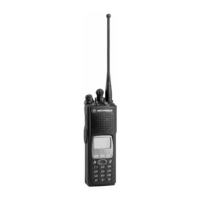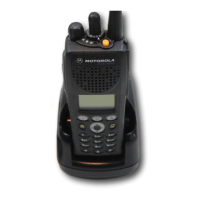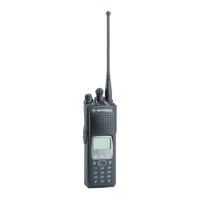July 16, 2004 6881094C28-D
8-18 Disassembly/Reassembly Procedures: Ensuring Radio Submergibility
8.10.7 Vacuum Test
The vacuum test uses a vacuum pump and gauge. The pump creates a vacuum condition inside the
radio, and the gauge monitors the radio for a stable vacuum reading; that is, checking for a properly
sealed, watertight unit. Before starting the vacuum test:
• Remove the battery.
• Remove the universal connector cover to expose the universal connector.
NOTE: Refer to the exploded view diagrams and parts lists found in “Chapter 10: Exploded Views
and Parts Lists” on page 10-1.
To conduct the vacuum test:
1. Attach the vacuum hose to the vacuum pump. Check the pump and hose for leaks by block-
ing off the open end of the hose and operating the pump a few times. The actual reading of
the gauge at this point is not important; it is important that the gauge pointer remains steady,
indicating no vacuum leaks in the pump.
2. Remove the vacuum test port using a pair of needle-nosed pliers and pulling upward.
3. Ensure that a rubber gasket is attached to the hose-to-casting adapter. Screw the adapter
into the tapped hole in the casting.
4. Attach the open end of the hose to the adapter.
5. Place the radio on a flat surface with the casting facing upward. Place two or three drops of
water on each slot of the label (62) that protects the vent port seal (61) on the casting. This
will ensure that no air goes through the seal.
6. Operate the pump a few times until the gauge indicates 5 in. Hg; do not pull more than 7 in.
Hg of vacuum on the radio.
7. Operate the pump again until the gauge indicates 6 in. Hg.
8. Observe the gauge for approximately 1 minute.
- If the needle falls 1 in. Hg or less (for example, from 6 in. Hg to 5 in. Hg), then the radio has
passed the vacuum test and is approved for submergibility. No additional testing will be
required.
- If the needle falls more than 1 in. Hg (for example, from 6 in. Hg to less than 5 in. Hg), then
the radio has failed the vacuum test and the radio might leak if submerged. Additional trou-
bleshooting of the radio will be required; complete this procedure, then go to the “Pressure
Test” section of this manual.
9. Dry the water from the slots on the label (62) that protects the vent port seal to allow the radio
to equalize. The pressure should drop slowly to “0.”
10. Remove the vacuum hose and adapter from the radio.
11. Install the vacuum test port plug by pressing it in, ensuring that the plug sits flat all around the
edges and it is flush with the casting.

